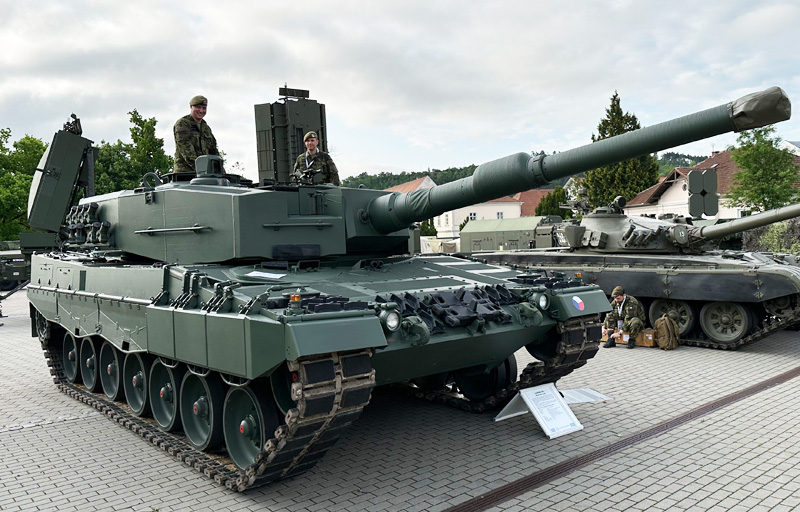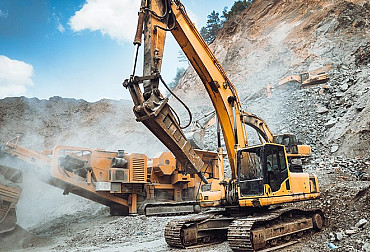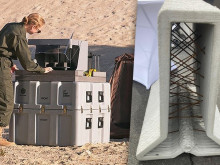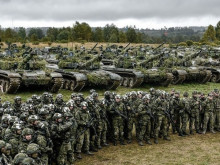Operation, maintenance and modernisation of Czech Leopard 2 tanks will benefit from the LEOBEN Club
In April, the Chief of the General Staff told the Defence Committee that modern tanks would enter the armament of the 73rd Tank Battalion in 2027-2030. At that time, the Army was preparing a feasibility study, on the basis of which the government subsequently decided to enter into negotiations with Germany for the joint purchase of up to 77 Leopard 2A8 tanks in six variants (combat, command, recovery - Büffel, engineer - Kodiak, bridge - Leguan, and for driver training). Together with the 14 Leopard 2A4 tanks and one Büffel recovery tank that the Czech Republic will receive as part of the so-called circular exchange, this amounts to 92 modern tanks, of which 60-70 are combat tanks. Their arrival will bring to an end for a long time a period of standstills when the Czech Army tankers were struggling with the low operability of the T-72M4 CZ tanks, which had to replace the obsolete T-72M1 tanks in service. The agreed parameters of industrial cooperation, and possibly the opening of an excellent line in the Czech Republic, mentioned in the media, will play a major role in this. The 2A4 tanks will be upgraded, and the T-72M4 tanks are planned to be stored by the Czech Army as part of the mobilisation reserve.
Video: Leopard 2 tanks in the Czech Armed Forces and the benefits of the LEOBEN club / CZ DEFENCE
The decision announced at the end of May ended a long period of speculation. Although the German Leopard 2 has been the clear favourite since the beginning of the considerations on the rearmament of the tank battalion, the market offers at least two other solutions that the army had to evaluate responsibly, namely the American Abrams tanks, which are coming into the Polish army's arsenal in the order of the lower hundreds, and the South Korean K2 Black Panther tanks, of which the Poles have purchased a thousand and are preparing their serial production on Polish territory. In addition to its excellent tactical and technical parameters, the Leopard is undoubtedly favoured by its widespread use in the armaments of the allied armies, the good experience gained over the decades of service of this platform, which is still characterised by its significant modernisation potential, and last but not least by the geographical proximity of its production and service base - the Krauss-Maffei Wegmann (KMW) company based in Munich.
The roots of Leopard 2 tank development go back to the 1970s. However, KMW has continued and continues to continue the development of the tank, with proven elements of the tank forming the basis of the next-generation MBT project, the MGCS (Main Ground Combat System). Thanks to the timelessness of the design, Leopard 2 remains at the cutting edge of technology and performance. The current variants of the Leopard 2A7 and the latest version 2A8 are based on the experience gained by the armed forces of various countries with the Leopard 2 of previous variants in combat operations in recent years, e.g. in Afghanistan, or in the problematic deployment of Turkish Leopard 2A4s in Syria against Islamic State fighters. Overall, the tank's durability and performance have been enhanced, along with improved electronic and targeting systems that in all respects stand up to the most rigorous contemporary benchmarks and comparisons with the world's most advanced tanks.
Most nations require local industry involvement for their weapons programmes, including in modernisation projects. This is commonly a requirement at the tender stage for the purchase of weapons, even if the demand is for only a few dozen units. In the past, KMW has in several cases accommodated requests for local production of the Leopard 2 tank, and such a possibility was recently mentioned by the media in the case of a negotiated joint purchase of modern tanks with Germany. Thus, a new production line in the Czech Republic is in play, which may bring a number of interesting opportunities for the Czech defence industry, and at the same time it will help to solve the current problem of the relatively low production capacity of 3-4 new Leopards per month, and bring it up to 20 new tanks, which is equivalent to the production capacity during the Cold War. With such a number, the rapid rearmament and re-equipment of the Allied armies can already be seen as realistic.
However, buying new tanks is not enough. The user always needs also an efficient maintenance system, service facilities and capacity for future upgrades. One of the reasons why the Leopard 2 has become such a widespread tank is the support system called LEOBEN (Leopard-benutzende Staaten) or LEO Users Club. In total, 18 countries have more than 3,500 Leopard tanks. These include Germany, Austria, Denmark, Finland, Greece, Poland, the Netherlands, Norway, Spain, Sweden, Switzerland, Canada, Turkey, and now also Hungary, the Czech Republic and Slovakia. It is not known whether Qatar and Indonesia are also part of the LEOBEN programme. In addition to the strengthening of the Bundeswehr and the rearmament of the Czech and Slovak tank battalions, Italy, which has expressed interest in more than 200 new Leopards, will probably play an important role in the future.
 Picture: The Leopard 2 A4 tanks will primarily be used to train soldiers of the 73rd Tank Battalion, including active reserves. They will ensure a smooth transition to the new type of main battle tank and its implementation into use in the Czech Army. | Michal Pivoňka / CZ DEFENCE
Picture: The Leopard 2 A4 tanks will primarily be used to train soldiers of the 73rd Tank Battalion, including active reserves. They will ensure a smooth transition to the new type of main battle tank and its implementation into use in the Czech Army. | Michal Pivoňka / CZ DEFENCE
The LEOBEN programme enables sharing of experience in tank operations, sharing of logistics and brings economic savings. LEOBEN countries work closely together in research and development, tank modernisation, repair, provision of spare parts or ammunition to make the operation of Leopard tanks as cost-effective as possible. Working groups with specific competences are part of the whole system. There is a working group for logistics cooperation, joint procurement of spare parts, maintenance planning and provision of ammunition. There is also a working group for tank servicing and maintenance, which also deals with technical modifications, vulnerability analyses and improvements. Finally, there is also a working group on combat systems modernisation and a joint research and development policy.
Thanks to the LEOBEN programme, Leopard 2 tank users can rely on strategic cooperation that reduces the cost of tank operations. The programme therefore means efficient spending on tank operations and essential logistics throughout the tank lifecycle, including upgrades and enhancements. Moreover, the number of tanks in operation in each army does not affect the cooperation. The cost of operating one tank is comparable to that of a German or Polish army with hundreds of tanks and Norway, which has purchased only a few dozen tanks, which plays an important role for the Czech Republic. This, too, was undoubtedly part of the considerations that eventually led representatives of the Ministry of Defence to decide to start negotiations on the acquisition of new Leopard 2A8 tanks jointly with Germany - on terms identical for both the German and Czech sides.
 Picture: In total, 18 countries have more than 3,500 Leopard tanks. These include Germany, Austria, Denmark, Finland, Greece, Poland, the Netherlands, Norway, Spain, Sweden, Switzerland, Canada, Turkey, and now also Hungary, the Czech Republic and Slovakia. (pictured here with Leopard 2A7) | KMW
Picture: In total, 18 countries have more than 3,500 Leopard tanks. These include Germany, Austria, Denmark, Finland, Greece, Poland, the Netherlands, Norway, Spain, Sweden, Switzerland, Canada, Turkey, and now also Hungary, the Czech Republic and Slovakia. (pictured here with Leopard 2A7) | KMW
Otherwise, not much is known about the LEOBEN program in open sources, apart from the Canadian Letter of Intent (LOI), which refers to LEOBEN in some respects. Accordingly, Canada uses the services of the LEOBEN club to manage standard configurations of Leopard and ARV (engineer variant) tanks. Canada also uses LEOBEN CoopLog services, however, repairs and overhauls and spare parts are currently procured exclusively through contracts with local industry. The document also states that Canada maintains LOEBEN for interoperability, as Leopard 2 tanks have no role in Canada other than training, and are intended for deployment abroad. Mention is made of the LEOBEN technology transfer process that Canada uses to support its industry.
The Czech Republic and Slovakia would undoubtedly take the same approach, either in a negotiated joint purchase or in their own acquisition project.





















